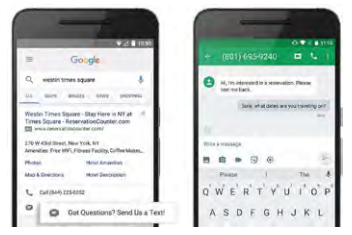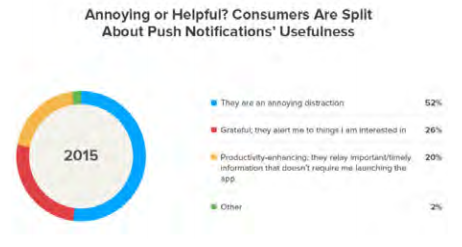7.4: Defining mobile channels
- Page ID
- 41678
While mobile is increasingly and inextricably interwoven with all aspects of marketing and as such shouldn’t be considered in isolation, there are some methods of communication that are only accessible via a mobile device.
Read more about these in the Direct marketing - email and mobile chapter.
SMS/MMS
SMS (short message service) and MMS (multimedia messaging service) are standard text messages sent via mobile phone over a cellular network. An MMS can also include various types of media such as images, audio, or a short video.
These are push methods for messaging, where the brand sends out the message to the customer. They also offer the opportunity to receive messages from consumers, for example, as feedback or in a competition. Google has released a click-tomessage ad extension that allows users to directly SMS a company from the search engine results pages, without having to look for a number on a web page.

Read more about ad extensions in the Search advertising chapter
Despite the ever-increasing popularity of smartphones and the associated instant messaging programs, SMS and MMS can still have their place in a good marketing strategy, particularly for relaying information, reminders, and automated confirmation.
USSD
USSD is a pull method of reaching your customer in that they need to come to you. The caller dials a number, usually starting with a * and ending with a #, and is sent a menu with various options. They can then enter the number that corresponds to their request.
USSD is a good way of collecting data from your user. Some brands use it to capture competition entries and survey answers. It can also be used for mobile commerce like when you buy more data for your phone by using airtime and can be used with location-based technology.
Bluetooth beacons
A beacon is a small low-energy Bluetooth device. It can transmit small packets of information across short distances. If a smartphone with the brand’s app installed comes into range, it can receive a notification of a discount, reward, suggestion, or anything else you want to send. This is still permission marketing, as the app has to be installed for it to work.
Also known as proximity marketing, this takes location-specific marketing from a general area to an exact location inside a store. It can be used to send targeted discount coupons, demonstration videos for products or directions to a nearby product.
AR/VR
Augmented reality superimposes computer graphics into the physical space around the person using an AR device (usually a smartphone or tablet). Virtual reality takes this a step further using products like Google Cardboard and 360-degree videos in an attempt to create an even more immersive interaction.

AR can use image recognition to turn images without markers, without a barcode, QR code, or other visible stamp, into triggers that launch an AR or VR experience. It can launch a link, open an app, dial a number and give directions. This can also be location-based, so a user in a store could start an app and see more information about the products in front of them.
AR and VR are not about direct marketing, but engagement, creating an exciting experience for their consumers that makes them want to engage with the brand.
Check out some good uses of augmented reality here: https:// www.lifewire. com/applicationsof-augmentedreality-2495561
Apps
An app is a software program designed to run on a mobile device like a smartphone or tablet. ’App’ can also refer to a web app or online app, which is software that you use while online via a browser. Most apps perform a very specific, narrow purpose, though some do not. The best apps take user needs into account, become a strong touchpoint for the brand, enable the sales of products, and importantly solve user problems. They can extend the reach of your business and, assuming you understand the needs of your audience and create an app that meets those needs, can also help build a relationship with your customers.
Apps vs. websites
Should your brand even have an app or can it afford to live without one? Every company seems to be releasing its own app these days, which is understandable, given that consumers spend 90% of their time on mobile in apps rather than a browser. These include social media apps, entertainment apps, games and news (Smart Insights, 2016).
Until about 2015, mobile browsers weren’t very good and even as they improved, websites became more bloated, hindering performance. Apps enable people to do something or access something quickly and easily on mobile. This means that many apps are essentially browsers designed for a specific purpose. SurveyMonkey lists the top five most popular apps in the USA for January to June of 2016 as:
- YouTube
- Messenger
- Google Maps
- Play Store.
The popularity of these apps demonstrates user interest in social networks, entertaining content and practical utility.

Despite arguably being glorified browsers, the advantages of apps are numerous.
- The easy access button on a home screen.
- Integration with the device’s operating system and the speed that comes with that and being locally installed.
- Access to native functions.
However, if your website isn’t already getting traffic, an app will not solve that problem.
In the USA, the number of app downloads is decreasing. Globally, because the mobile phone market is still increasing, app downloads are increasing too but, with a few exceptions, not by very much. Of course, once the apps are downloaded, they are of no use unless the smartphone user actually uses them. A survey from the Pew Research Center found that 46% of respondents use six to ten apps per week, and 35% use six to 10; AppsFlyer found that most apps aren’t even kept for a full day, with only 3.3% of Android apps and 3.2% of iOS apps still boasting active users after 30 days (eMarketer, 2015).
With more than 2.5 million available apps and users averaging 17−20 apps per device, the app market is saturated, which means that to stand out, you need to offer users something they really want.
Does this mean that you shouldn’t bother with an app, should you just stick to a website and make sure that it offers the user an excellent browsing experience? Not necessarily. If you do decide to make an app, make sure there is a need for it, for instance:
- If the user needs to do something location-specific.
- If you need to do push messaging (see below).
- If you need to do something graphics-heavy that can’t be done with videos on YouTube or Facebook.
- If your service requires the storing of sensitive user information like credit card information on the users’ phone.
Look at your connected consumer and ask how an app will make a large, continuous improvement to the service you offer. Creating an app simply for its own sake will lose you time and money.
One example of a brand having great success with its app is Starbucks. The app does very well because:
- It is location-specific: The app makes finding the nearest Starbucks very easy. It also uses GPS to determine which store a user is at and then shares music information for that location. Users can then save songs they hear in the store to a playlist within the app and access and keep listening to the music after they leave.
- It uses gamification: The loyalty programme is tiered, with extra freebies and benefits for people higher up.
- It uses functions that are specific to the mobile phone, like GPS.
- It allows people to order and pay in advance by mobile before picking up the drink.
- It engages customers using special incentives and bonuses to encourage continued app use.
- It encourages a social aspect, the rewards offered by the loyalty programme make customers feel exclusive, and they are then more likely to share updates on social media.
- It makes access to user data very easy. It also uses in-app messages to encourage users to fill out surveys in exchange for more stars for the loyalty programme.
- It offers a lot of opportunity for branding.
- It plans to expand the app to make personalised recommendations, which will increase in-app purchases.
(Digital Turbine, 2016).
Starbucks has used its app to expand on its existing offering and to differentiate its loyalty programme from those of similar brands by catering to the needs of its mobile audience.
Push notifications
Push notifications let your app send messages to the user even when your app is not active. The app’s icon and a message appear in the status bar, for example when you receive a message on Facebook or WhatsApp or when Memrise sends you a daily reminder to study.
Push notifications, like anything else on mobile, rely on permission marketing; people have to opt in to receive these notifications. The notifications do need to be optimised to ensure that the user pays attention (the majority of users are annoyed by them).

People want personalised push messages that are relevant to their needs, arrive at the right time, and don’t come too often.
Other
Other mobile-specific channels exist, such as QR codes and near-field communications (NFC). For the most part, these will fall into other areas of digital marketing. NFC can be used for payment or ticketing, QR codes for launching AR experiences or for payment, so we will not go into detail on those here.
Wearables such as smartwatches and fitness monitors are a rapidly expanding market, though apart from gathering data, marketers are still struggling to determine their impact on our behaviour, expectations, and marketing strategies.
Their biggest strength is their ability to reduce the time between a user developing intent and taking action. On the other hand, people don’t check their phones as often if they have a wearable to alert them when something happens, which will reduce the number of impressions your marketing messages receive.
For now, the best advice we can give for approaching wearables is to consider what kind of information people want and need to see and how you can use that to encourage engagement. Wearables are something that marketers need to experiment with.
Take a look at Emirates NBD bank’s use of wearables synched to mobile devices to promote its savings accounts by giving better interest rates to customers who kept fit: www.digitaltrainingacademy.co...udies/2016/10/ gamification_case_study_emirates_bank_rewards_exercise_with_better_ savings_via_fitness_app.php
It’s important to remember that mobile is a layer on top of all of your other marketing activities. As a marketer, you should never start by deciding what mobile channel you’re going to use and then plan a campaign. Instead, find out where your audience is and what kind of devices they use to access the Internet, and use that to inform what kind of channels and campaign you will plan. For example, if they are more likely to access your campaign at work, desktop channels might be the best way to go.


